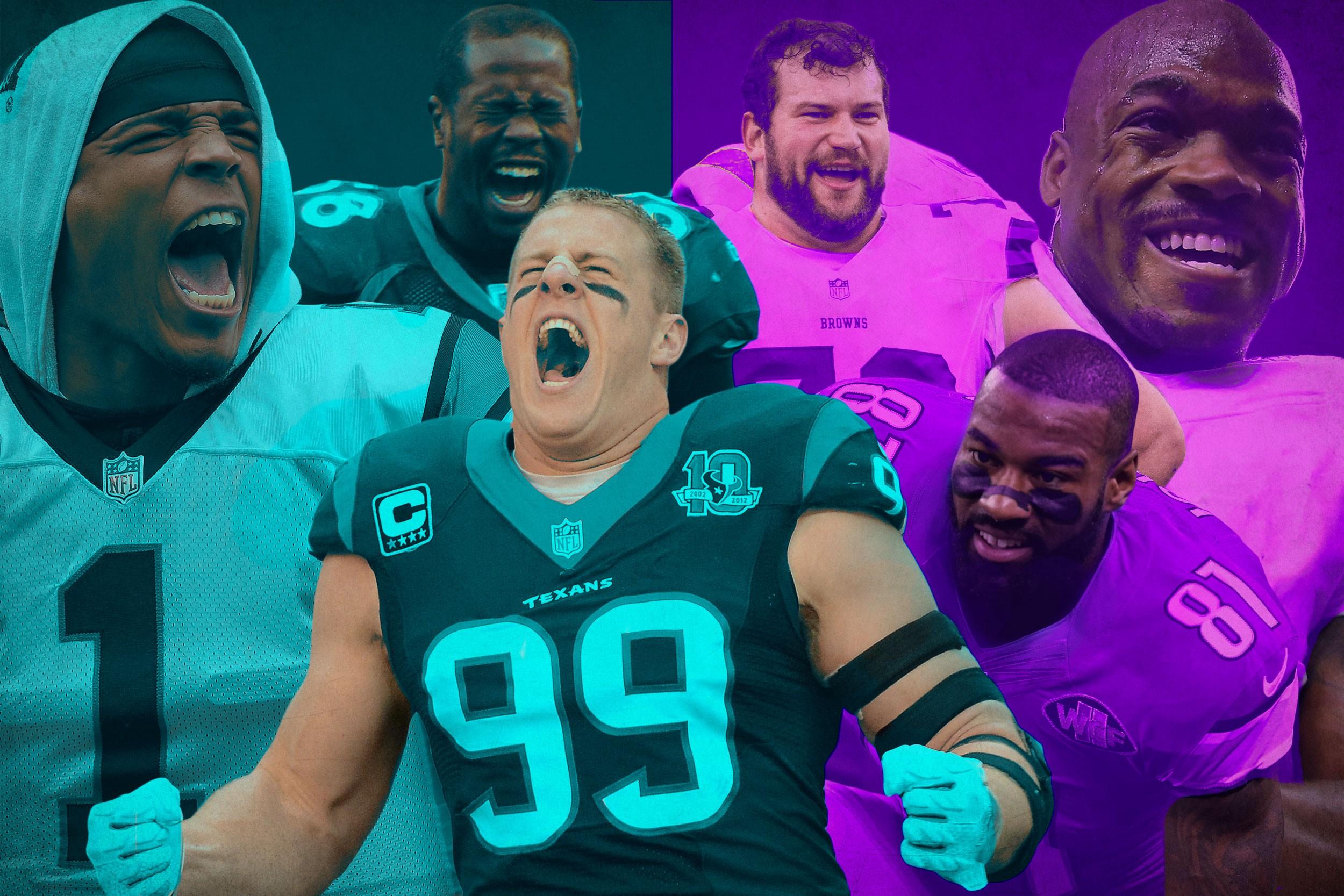
The best part about NFL draft season, outside of the endless speculation and dart-throwing that surrounds a given year’s class, is poring over old drafts and questioning how they ever could’ve unfolded in the way that they did. In some cases — such as the doomed 2013 class, which looks worse by the day — that involves attempting to pinpoint how it all went wrong. Just as often, though, we reflect on drafts packed with so much greatness that, in hindsight, it’s tough to believe we couldn’t foresee how excellent a class was going to become.
Over the past decade, two such drafts have been a cut above the rest. The 2007 class, whose stars are already either retired or in the twilight of their careers, featured a top 15 that could rival any in league history. Before the top half the first round was complete, Calvin Johnson (Lions), Joe Thomas (Browns), Adrian Peterson (Vikings), Patrick Willis (49ers), Marshawn Lynch (Bills), and Darrelle Revis (Jets) were gone. By the time Jets fans even had a chance to hurl the first of many profanity-laced tirades at commissioner Roger Goodell, a handful of players now bound for the Hall of Fame — and JaMarcus Russell — were off the board. Plenty of monumental busts have come and gone, but Russell going no. 1 overall with a slew of future legends sitting in the green room remains an all-time misstep. I’m glad Raiders fans finally get to enjoy a well-deserved period of stability and harmony in Oakland.
The players from the 2011 draft aren’t quite as heralded as those from 2007 (at least not yet), but they’ve dominated since coming into the league. It took hardly any time for Cam Newton, Von Miller, Aldon Smith, J.J. Watt, Patrick Peterson, and A.J. Green to make immediate impacts, and even beyond the guys taken near the top of the first round, the 2011 class has produced an army of capable starters.
Any debate about the best draft in recent memory comes down to these two years. So, a decade removed from that 2007 class, it’s a good time to figure out which was better, and I can think of only one way to ensure we come to the right conclusion — by using a completely made-up points system!
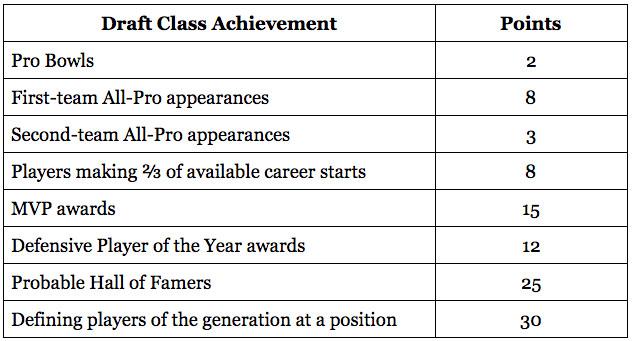
For the sake of transparency, it’s worth going through the thinking here. Some of these categories speak for themselves, while others are less obvious.
- The Pro Bowl has become such a nonsense event that putting major stock into it feels dubious, even if it remains a reasonable assessment of which players mattered in a given league year. That the two trips for Brandon Meriweather and Jurrell Casey count for the same amount of points physically pained me, but those are the pitfalls of going with a one-size-fits-all system.
- Special teams Pro Bowl berths of any kind — for kickers, punters, specialists, and coverage guys — weren’t included in this system. Weighing a long snapper’s Pro Bowl appearance the same way we would Greg Olsen’s just didn’t seem right.
- It was important to recognize how valuable it is to find a player who can just stay on the field and factor into his team’s game plan for the majority of his career. Giving points to those who started two-thirds of the games they could have felt like the sweet spot in emphasizing that idea. Players like Leon Hall, Brandon Mebane, and Nate Solder make the quality of any draft better. That should be recognized in an exercise like this.
- There’s a difference between being a future Hall of Fame running back and being the running back in the NFL for a generation, and that should be reflected in how the points are awarded. That’s where the "defining player" category comes in. Deciding what measure of time a generation spans is debatable, but for the purpose of this exercise, let’s designate it as a 10-year stretch beginning when a player was drafted. Take Patrick Willis, for example. Willis retired following the 2014 campaign, but for the 10 seasons after he was drafted (2007 to 2016), I’d contend that he defined the inside linebacker position in the NFL, despite guys like Ray Lewis and Brian Urlacher playing out the latter parts of their careers. The goal here is to recognize which of these drafts should go down as the best; the holy-shit factor of the names in the class matters.
All right, with that out of the way, let’s get into it.
2007
Top point-getters: Joe Thomas (137), Adrian Peterson (133), Patrick Willis (120), Darrelle Revis (109), Calvin Johnson (102), Marshal Yanda (100), Marshawn Lynch (54), Eric Weddle (41), Ryan Kalil (37), Joe Staley (27)
Probable Hall of Famers: Johnson, Thomas, Peterson, Willis, Lynch, Revis, Yanda
Defining players of the generation at a position: Johnson, Thomas, Peterson, Willis, Revis, Yanda
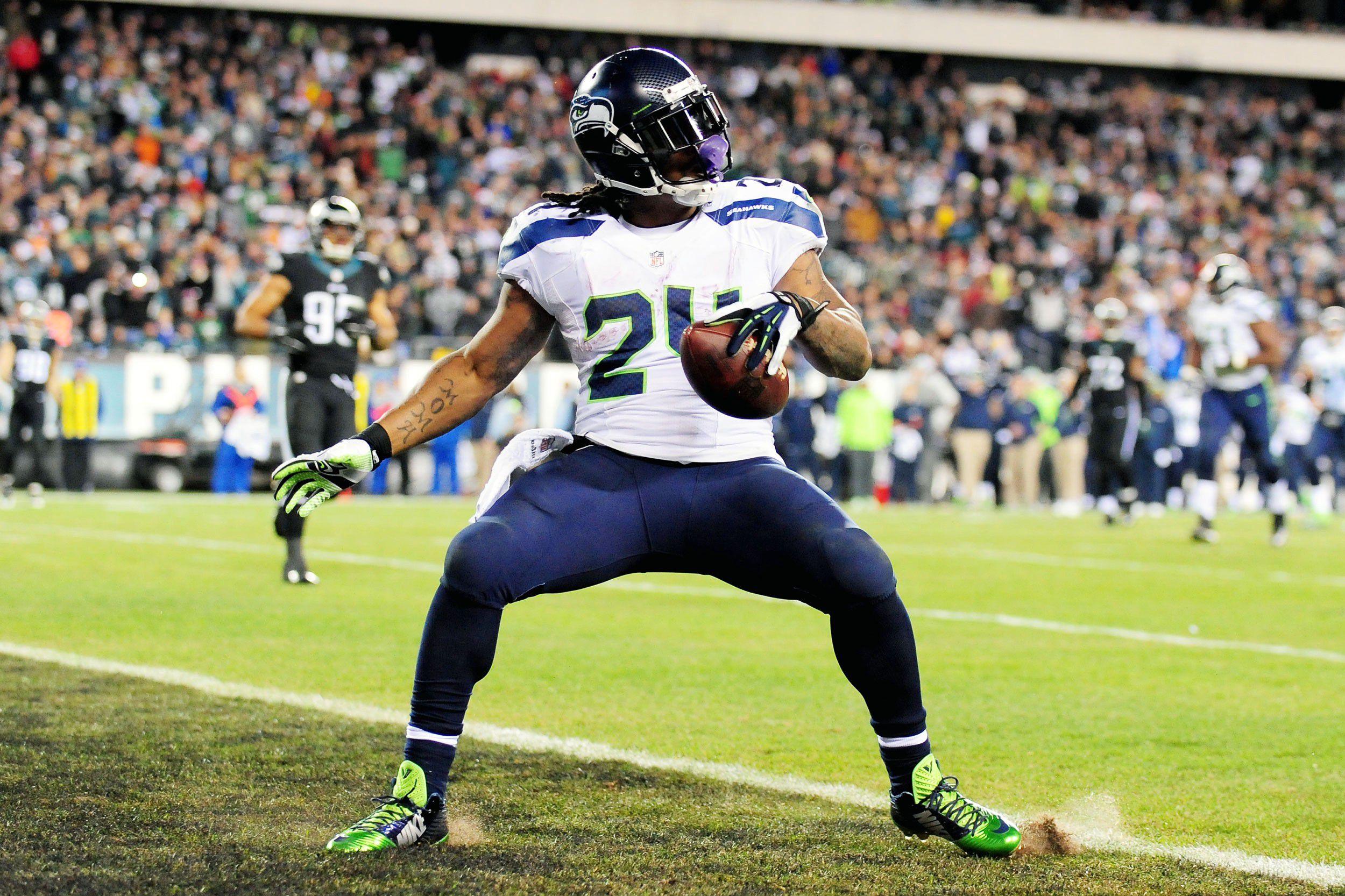
The run in the first half of this draft was historically ridiculous. There’s an argument to be made that the wide receiver, running back, left tackle, linebacker, and cornerback of the past 10 years were all selected in the first 14 picks of the 2007 draft. Marshawn Lynch — Marshawn Lynch, who has done more for our collective enjoyment than nearly any other human in history — is maybe the fifth-most iconic player taken in that stretch. The six deserving Hall of Fame candidates selected during this run lay claim to a combined 23 first-team All-Pro selections, 42 Pro Bowl selections, and one MVP award (Peterson in 2012) between them. Somehow, that doesn’t seem like enough.
A quiet factor helping the 2007 case is that the all-time greats it produced don’t all come from this legendary first-round contingent. Marshal Yanda, longtime Ravens guard, was grabbed in the third round at no. 86 overall. Before you cry line nerd, hear me out. Yanda has been to the same number of Pro Bowls (six) as Calvin Johnson, and has just one fewer first-team All-Pro bid (two). He has been voted first- or second-team All-Pro five times in the past six years. And if the gap between Megatron and his contemporaries at the position is a sticking point, well, allow me to present … Marshal Yanda’s career. Like some of his draft mates, Yanda is the player of a generation at his position, and as such, deserves the same treatment afforded to the other names involved here. OK, line-play tirade over.
The problem with the 2007 group after the murderers’ row to start is, well, almost everything else. Lack of depth is a concern, and that’s especially true going beyond the first round. Reggie Nelson (no. 21), Joe Staley (no. 28), and Greg Olsen (no. 31) were all great finds in the back half of the round, although Olsen and Nelson were eventually great for teams other than the ones that drafted them. (No, you’re still bitter.) Keep moving, though, and the talent pool quickly dries up.
Excluding Yanda, who would be an outlier in every draft, only two players taken after the first round put up significant points in this system: longtime Chargers and current Ravens safety Eric Weddle and Panthers center Ryan Kalil. Especially compared to the 2011 group, there weren’t many reliable starters to be found. After Weddle, the no. 37 overall pick, only 14 players in this draft went on to start at least two-thirds of the available games in their careers.
As I went through the 2007 list, it became clear that evaluating drafts with a points system is far from perfect. Carolina defensive end Charles Johnson registers in none of the categories. That seems impossible, but really — go look. Despite finishing three seasons with at least 11 sacks, Johnson hasn’t been to the Pro Bowl. Because he started only four games over his first three seasons, his total falls just below the two-thirds cutoff. Before the 2011 campaign, Johnson signed a six-year deal worth a potential $76 million (with $32 million guaranteed), and he almost made it through the whole thing. What I’m saying is — good for you, Charles Johnson. He may have been miscast as an NFL defense’s leading man, but he’s been a vital piece of every team that he’s been on, he’s cashed in financially, and he’s done everything asked of him. He’s the Paul Giamatti of defensive ends.
For the most part, though, the system used accurately depicts this class’s strength. And in the case of players taken toward the top of this draft, it factors in the weight of their all-timer status. I count six (Calvin Johnson, Thomas, Peterson, Willis, Yanda, and Revis) 2007 draftees as defining generational players at their positions. Just ruminate on that for a second. It’s no guarantee that any first round will produce six Pro Bowl players, let alone six superstars, let alone six guys who have to be mentioned in any debate about the best players of the past quarter-century. The quality of a draft isn’t determined solely by a handful of huge names, but having this many goes a long way toward making one great. How long some of those players can hold onto the belt (Patrick Peterson and Luke Kuechly are pushing Revis and Willis, respectively) is a different story — and one that could shift the balance of power in future comparisons between the 2007 and 2011 drafts.
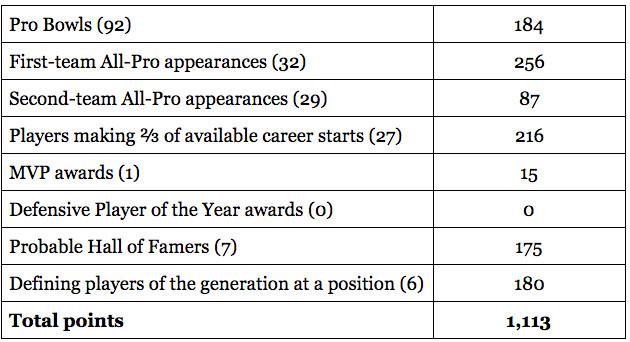
2011
Top point-getters: J.J. Watt (139), Von Miller (103), Patrick Peterson (69), Richard Sherman (68), Tyron Smith (63), Julio Jones (57), A.J. Green (51), Cam Newton (37), Justin Houston (24), DeMarco Murray (22)
Probable Hall of Famers: Miller, Green, Peterson, Jones, Smith, Watt, Sherman
Defining players of the generation at a position: Miller, Watt
To get a handle on just how great the top of the 2011 class was, peruse the list of award-winners from the 2015 season. The MVP, Cam Newton, went no. 1 overall. The Super Bowl MVP/King of the Playoffs, Von Miller, went second. The Defensive Player of the Year, J.J. Watt, went 11th. And things don’t slow down from there. Here’s the simple rule with the top of the 2011 class: Any franchise that took a quarterback not named Newton is probably haunted by that pick to this day. Any team that didn’t found a superstar. So, not that big of a difference. (Sorry, Jaguars fans. I really am.)
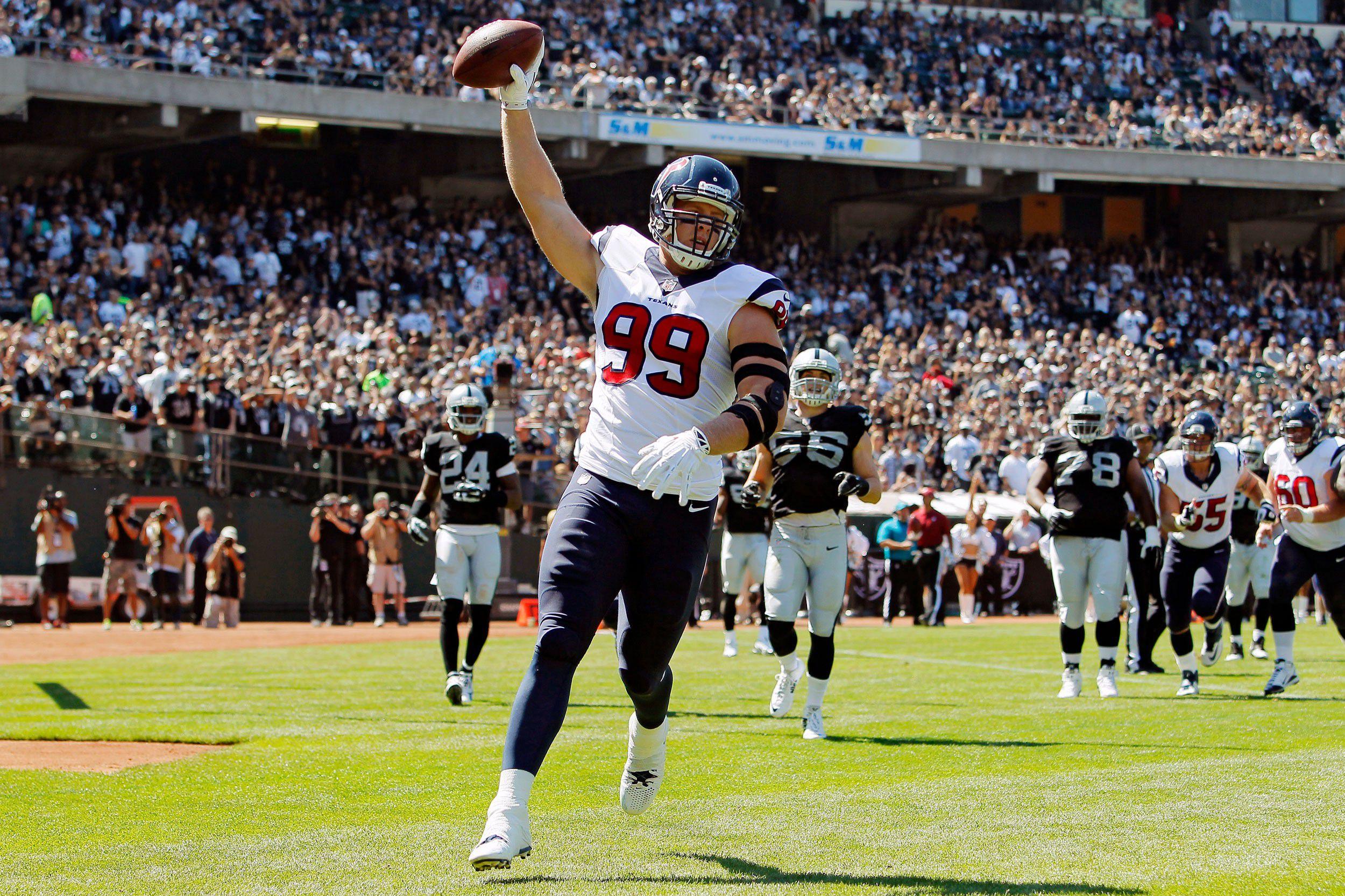
Some early standouts from 2011 have seen their careers derailed after promising starts — Aldon Smith’s trajectory has clearly taken a turn for the worse, while Marcell Dareus has faced issues over the past few years after enjoying a career season in 2014 — but for the most part, the players taken in the first 11 picks of this draft remain some of the league’s most visible franchise cornerstones. The Bengals, Cardinals, Falcons, and Cowboys all passed on Watt, who’s won three Defensive Player of the Year awards in six seasons, and not one of them likely regrets it. Tyron Smith, who Dallas picked two spots ahead of Watt, has earned four first- or second-team All-Pro selections and won’t turn 27 until December. I’m 29 and feel like I should be commended for taking the time to reheat my pizza in the oven.
Despite the presence of guys like Smith, Julio Jones, and Peterson, though, Watt is responsible for a good chunk of the points in this draft. The system credits him with 139 total points (if we concede that he’s on a Hall of Fame track and is the defining defensive lineman of this generation, both of which I’d contend are true). The 2011 class has its own version of Yanda — a late-round gem who deserves mention alongside the guys from the top 10 — in Richard Sherman. Considering the other defensive talent in this draft, his name here is almost unfair.
What really separates the 2011 draft is how many steady, "Oh yeah, him" NFL players teams found that year. Thirty-seven members of the 2011 class have started at least two-thirds of their career games, and only 16 were selected in the first round. In addition to the Julio-Watt-Miller class of stars, there is a bounty of Pro Bowl–caliber talent: Jurrell Casey and DeMarco Murray were both third-round picks; the Chiefs cleaned up with Rodney Hudson in the second round and Justin Houston in the third; the Seahawks outdid everyone by landing K.J. Wright in the fourth before snagging Sherman in the fifth.
The best way to understand the extent of this group’s depth is by looking at how many top-of-the-market second contracts were handed out to 2011 draftees. Dareus, Casey, Cameron Jordan, Robert Quinn, Corey Liuget, Cameron Heyward, Muhammad Wilkerson, and Ryan Kerrigan all received deals that placed them among the highest-paid players in the league at their respective positions. The prudence of some of those signings may be up for debate, but the amount of them makes clear how many players from that class were seen as home run picks by the teams that drafted them.
Even a step down from that tier, the 2011 draft features another layer of players that the 2007 group lacks. In fact, nowhere do these two drafts diverge more than in that regard. The 2011 class is littered with consistent contributors such as Clint Boling, Marcus Gilbert, and Marcus Gilchrist. Gilbert, the Steelers’ reliable-as-hell right tackle, is anonymous to most of the football-watching public, but he embodies what makes this class so great. Finding plug-and-play starters after the first round is never easy for franchises. With this group, they pop up everywhere. While the 2007 class had more firepower at the top, the 2011 group had significantly more depth.
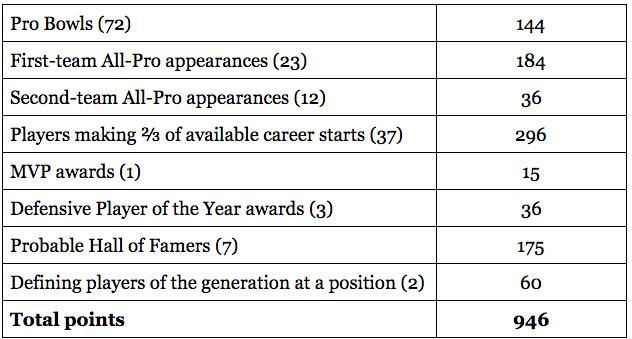
My fear before completing this exercise was that I would tally everything up and the result would be a landslide, a pummeling I should have been able to predict from the start. Thankfully, that wasn’t the case at all.
The 2007 draft class edged out the 2011 group by a mere 167 points, and even that gap is somewhat misleading. It had a four-season head start, so it’s reasonable to assume that the 2011 draft will close in — and possibly surpass 2007 — with the benefit of time. Miller will pile up a few more first-team All-Pro selections. Jones will go to more Pro Bowls. Watt could add another Defensive Player of the Year trophy to his mantle.
Come 2020, it’s entirely possible that Peterson has separated himself from his fellow cornerbacks, or that Jones embarks on a run that leaves Antonio Brown in the dust and solidifies him as the receiver of a generation. Based on the knowledge we have, though, the 2007 class has the upper hand on the strength of its transcendent core. The list of headliners from that draft is astounding. It also makes it all the more remarkable that the 2011 class could one day be seen as superior.